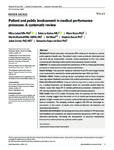Patient and public involvement in medical performance processes: A systematic review
| dc.contributor.author | Lalani, M | |
| dc.contributor.author | Baines, Rebecca | |
| dc.contributor.author | Bryce, Marie | |
| dc.contributor.author | Marshall, M | |
| dc.contributor.author | Mead, S | |
| dc.contributor.author | Barasi, S | |
| dc.contributor.author | Archer, Julian | |
| dc.contributor.author | Regan de Bere, Sam | |
| dc.date.accessioned | 2018-12-12T09:14:55Z | |
| dc.date.issued | 2019-04 | |
| dc.identifier.issn | 1369-6513 | |
| dc.identifier.issn | 1369-7625 | |
| dc.identifier.uri | http://hdl.handle.net/10026.1/13014 | |
| dc.description.abstract |
<jats:title>Abstract</jats:title><jats:sec><jats:title>Background</jats:title><jats:p>Patient and public involvement (<jats:styled-content style="fixed-case">PPI</jats:styled-content>) continues to develop as a central policy agenda in health care. The patient voice is seen as relevant, informative and can drive service improvement. However, critical exploration of <jats:styled-content style="fixed-case">PPI</jats:styled-content>'s role within monitoring and informing medical performance processes remains limited.</jats:p></jats:sec><jats:sec><jats:title>Objective</jats:title><jats:p>To explore and evaluate the contribution of <jats:styled-content style="fixed-case">PPI</jats:styled-content> in medical performance processes to understand its extent, purpose and process.</jats:p></jats:sec><jats:sec><jats:title>Search strategy</jats:title><jats:p>The electronic databases PubMed, Psyc<jats:styled-content style="fixed-case">INFO</jats:styled-content> and Google Scholar were systematically searched for studies published between 2004 and 2018.</jats:p></jats:sec><jats:sec><jats:title>Inclusion criteria</jats:title><jats:p>Studies involving doctors and patients and all forms of patient input (eg, patient feedback) associated with medical performance were included.</jats:p></jats:sec><jats:sec><jats:title>Data extraction and synthesis</jats:title><jats:p>Using an inductive approach to analysis and synthesis, a coding framework was developed which was structured around three key themes: issues that shape <jats:styled-content style="fixed-case">PPI</jats:styled-content> in medical performance processes; mechanisms for <jats:styled-content style="fixed-case">PPI</jats:styled-content>; and the potential impacts of <jats:styled-content style="fixed-case">PPI</jats:styled-content> on medical performance processes.</jats:p></jats:sec><jats:sec><jats:title>Main results</jats:title><jats:p>From 4772 studies, 48 articles (from 10 countries) met the inclusion criteria. Findings suggest that the extent of <jats:styled-content style="fixed-case">PPI</jats:styled-content> in medical performance processes globally is highly variable and is primarily achieved through providing patient feedback or complaints. The emerging evidence suggests that <jats:styled-content style="fixed-case">PPI</jats:styled-content> can encourage improvements in the quality of patient care, enable professional development and promote professionalism.</jats:p></jats:sec><jats:sec><jats:title>Discussion and conclusions</jats:title><jats:p>Developing more innovative methods of <jats:styled-content style="fixed-case">PPI</jats:styled-content> beyond patient feedback and complaints may help revolutionize the practice of <jats:styled-content style="fixed-case">PPI</jats:styled-content> into a collaborative partnership, facilitating the development of proactive relationships between the medical profession, patients and the public.</jats:p></jats:sec> | |
| dc.format.extent | 149-161 | |
| dc.format.medium | Print-Electronic | |
| dc.language | en | |
| dc.language.iso | en | |
| dc.publisher | Wiley Open Access | |
| dc.subject | medical performance | |
| dc.subject | patient involvement | |
| dc.title | Patient and public involvement in medical performance processes: A systematic review | |
| dc.type | journal-article | |
| dc.type | Journal Article | |
| dc.type | Research Support, Non-U.S. Gov't | |
| dc.type | Systematic Review | |
| plymouth.author-url | https://www.webofscience.com/api/gateway?GWVersion=2&SrcApp=PARTNER_APP&SrcAuth=LinksAMR&KeyUT=WOS:000462254400003&DestLinkType=FullRecord&DestApp=ALL_WOS&UsrCustomerID=11bb513d99f797142bcfeffcc58ea008 | |
| plymouth.issue | 2 | |
| plymouth.volume | 22 | |
| plymouth.publication-status | Published | |
| plymouth.journal | Health Expectations | |
| dc.identifier.doi | 10.1111/hex.12852 | |
| plymouth.organisational-group | /Plymouth | |
| plymouth.organisational-group | /Plymouth/Faculty of Health | |
| plymouth.organisational-group | /Plymouth/Faculty of Health/Peninsula Medical School | |
| plymouth.organisational-group | /Plymouth/REF 2021 Researchers by UoA | |
| plymouth.organisational-group | /Plymouth/REF 2021 Researchers by UoA/UoA23 Education | |
| plymouth.organisational-group | /Plymouth/Research Groups | |
| plymouth.organisational-group | /Plymouth/Research Groups/Institute of Health and Community | |
| plymouth.organisational-group | /Plymouth/Users by role | |
| plymouth.organisational-group | /Plymouth/Users by role/Academics | |
| dc.publisher.place | England | |
| dcterms.dateAccepted | 2018-11-07 | |
| dc.rights.embargodate | 2018-12-18 | |
| dc.identifier.eissn | 1369-7625 | |
| dc.rights.embargoperiod | Not known | |
| rioxxterms.versionofrecord | 10.1111/hex.12852 | |
| rioxxterms.licenseref.uri | http://www.rioxx.net/licenses/all-rights-reserved | |
| rioxxterms.licenseref.startdate | 2019-04 | |
| rioxxterms.type | Journal Article/Review |


